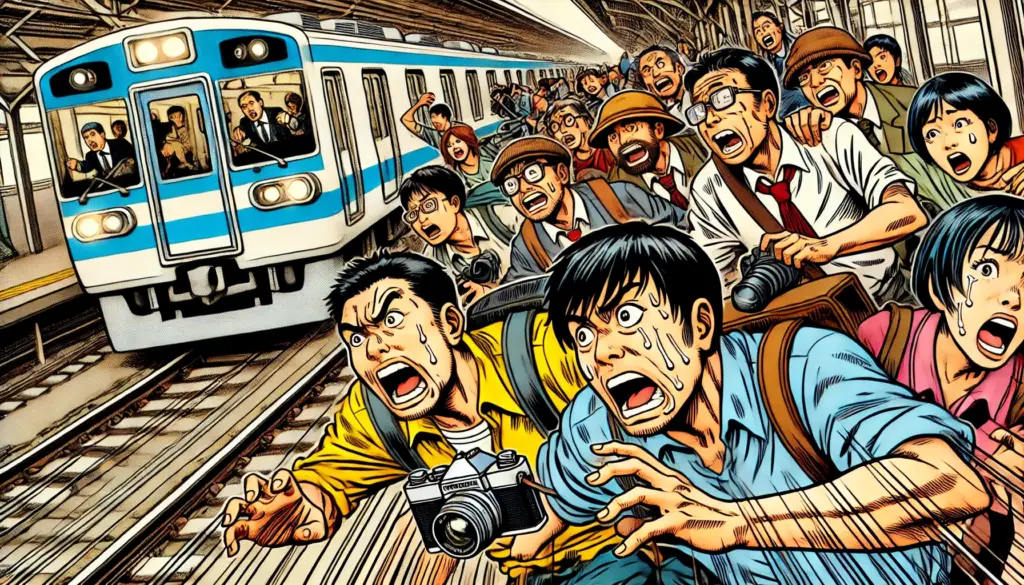
Rail photography, or “toritetsu,” may sound like a harmless and wholesome hobby. Yet in recent years, it has become a growing social problem in Japan. While most train enthusiasts enjoy their passion respectfully, a small group of rule-breaking individuals has tarnished the entire community’s image — sometimes even causing trains to be delayed. These incidents have triggered public resentment and forced railway companies to take stronger action.
🚆 1. When a Hobby Disrupts Thousands of Lives
In some cases, a single person stepping onto the tracks to capture the “perfect shot” has delayed trains for tens of minutes, affecting the schedules of hundreds or even thousands of passengers. Japan’s train system is famous for its punctuality, and any disruption — even a few minutes — can have a ripple effect on commuters, students, and businesses.
For many people, this transforms what might have been seen as a quirky subculture into an outright public nuisance.
📸 2. The Dual Face of “Toritetsu”
Most railway fans quietly photograph trains from safe locations, share their images online, and contribute positively to train culture. But the troublemakers — often labeled as “nuisance toritetsu” — behave differently:
- Setting up tripods in narrow spaces, blocking other people’s view or movement
- Entering private property or farmland without permission
- Standing too close to tracks, risking accidents
- Shouting at staff or other photographers to secure the “best” position
These actions cross the line from enthusiasm into dangerous and antisocial behavior.
😡 3. Why Society Resents Them
They Don’t Financially Support the Railways
Other train fans, such as “noritetsu” (who enjoy riding trains), buy tickets and help fund railway operations. Many nuisance toritetsu, however, travel by car to photo spots and avoid paying for train rides. In the eyes of railway companies, they bring safety risks and operational costs without contributing to revenue.
They Create Safety Hazards
Intruding onto tracks forces trains to brake suddenly. This not only risks injuries but can damage train wheels, leading to costly repairs and even service cancellations. Such acts directly undermine the trust in Japan’s famously reliable train network.
They Damage the Hobby’s Reputation
Because media reports tend to focus on extreme incidents, the public often associates all toritetsu with reckless behavior — even though the majority follow the rules. This stigma has led to growing tension between train fans and the general public.
📲 4. What’s Driving These Incidents?
Several factors seem to fuel the rise in problematic behavior:
- Rarity of events: Retiring train models or limited-edition designs create fierce competition for the “last chance” photo.
- Group mentality: In large gatherings, individuals may feel less accountable and more willing to bend or break rules.
- Social media rewards: Dramatic or daring shots often go viral, encouraging risky stunts in pursuit of online likes and shares.
The combination of these factors can turn a peaceful gathering into a chaotic scramble.
🛡️ 5. Railway Companies Fight Back
Rail operators have begun introducing various countermeasures:
- Designated photography areas: Special zones are set up to keep photographers away from dangerous spots.
- Event cancellations: When safety risks become too high, some companies have canceled photo-friendly events altogether.
- Increased security presence: Staff and security guards are deployed to popular train spots during high-demand events.
- Public awareness campaigns: Announcements, posters, and social media posts remind fans of the rules and potential penalties.
These measures aim to protect both railway operations and the safety of fans themselves.
🤝 6. Rebuilding Trust Between Fans and Operators
For this situation to improve, both sides need to work together:
- Responsible self-policing: Veteran fans can help guide newcomers on proper etiquette.
- Collaborative events: Railway companies could host supervised photography days, turning the hobby into a more cooperative experience.
- Clearer rules and enforcement: Firm penalties for trespassing or obstruction can discourage dangerous acts while allowing safe photography to continue.
🌏 7. Final Thoughts
The fascination with trains is deeply rooted in Japanese culture, and railways are an iconic part of the nation’s identity. The passion of toritetsu has the potential to preserve history, document change, and inspire future generations — but only if it’s pursued responsibly.
When a few enthusiasts ignore safety and etiquette, it damages public perception and risks the very access they value. By balancing passion with respect, the community can ensure that rail photography remains a beloved part of Japan’s cultural landscape rather than a headline-grabbing problem.



















































